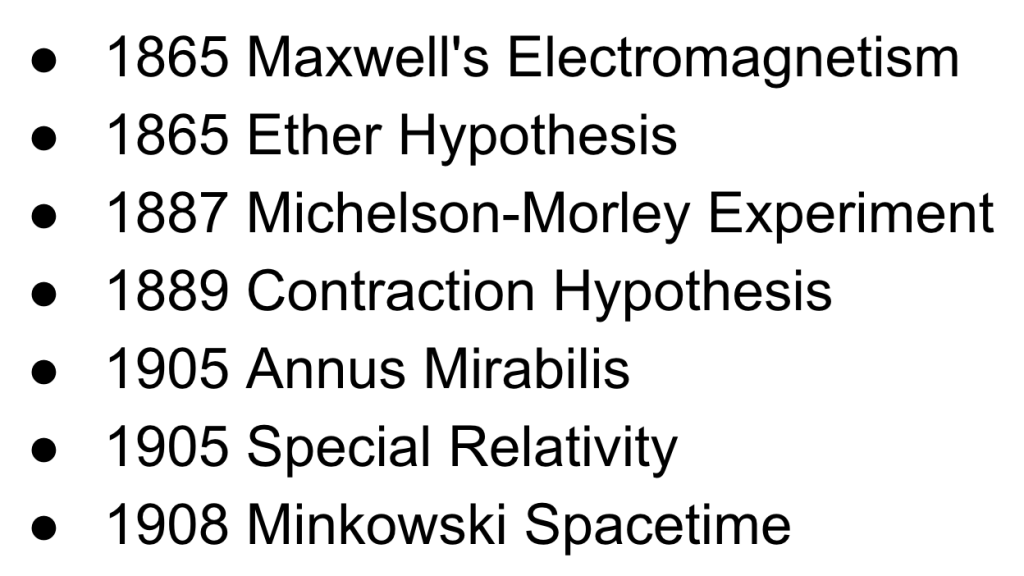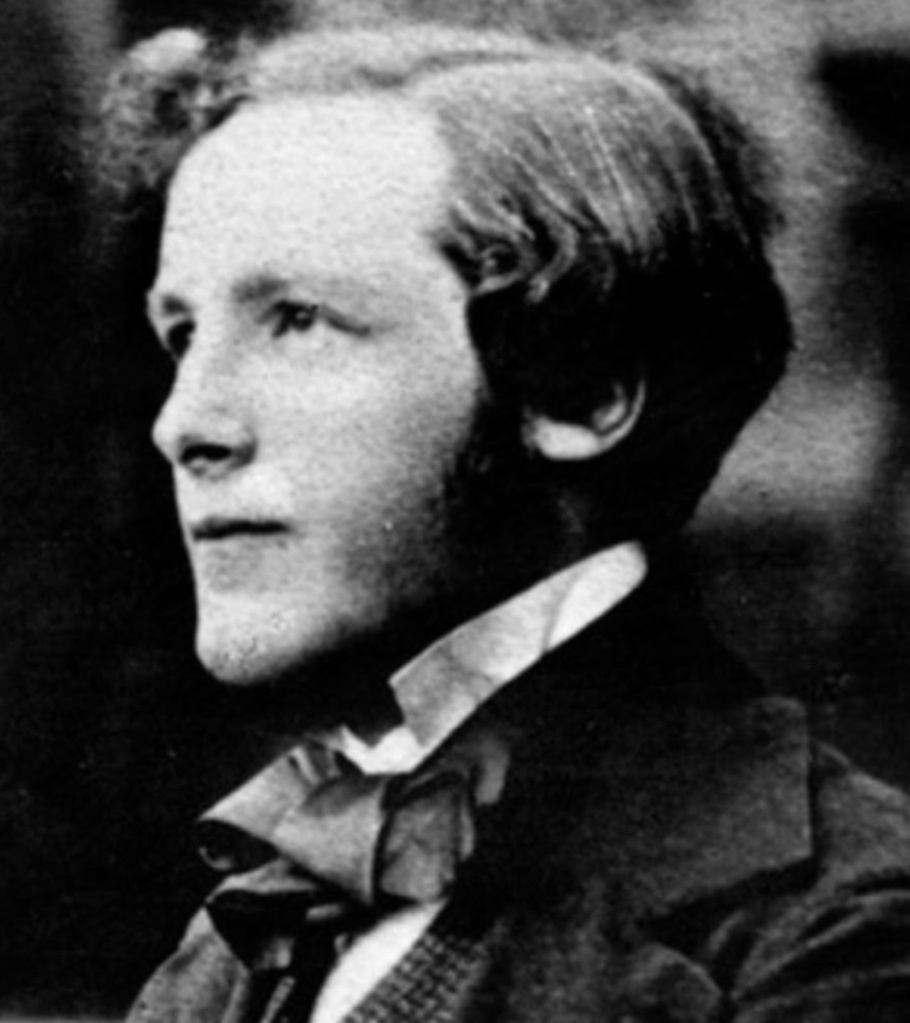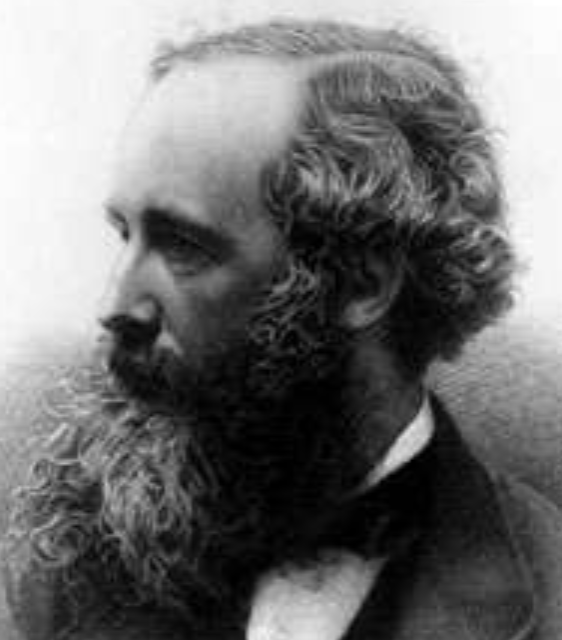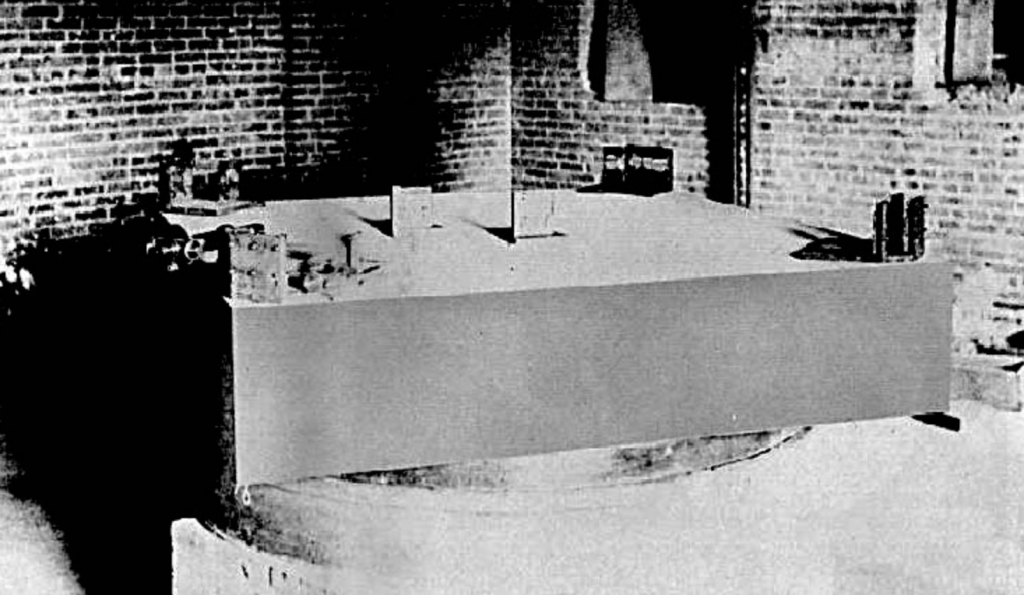Back to Special Relativity
Table of Contents
Timeline

1865 Maxwell’s Electromagnetism
- Electromagnetism is the theory of the electromagnetic force, governing electricity and magnetism.
- Maxwell derived from the postulates of his theory that electrical and magnetic fields can produce each other, generating waves propagating at the speed of light. Heinrich Hertz confirmed the prediction by creating radio waves.
- Beyond the formal theory of electromagnetism Maxwell conjectured that:
- Light is an electromagnetic wave
- The speed of an electromagnetic wave is relative to a substance call the ether


1865 Ether Hypothesis
- The ether, also called the luminiferous ether, was theorized to be a weightless, transparent, frictionless substance, permeating all matter and space, and acting as the medium for transmitting electromagnetic waves
- Two arguments for the existence of the ether
- Waves require a waving medium. So, electromagnetic waves require a medium of some kind, just as sound waves require an elastic medium such as air.
- Velocity is relative. Therefore the velocity of light is relative to something.
- Airspeed and ground speed
- A person running on a moving walkway
- Earth moving through space

- Thus, Maxwell and others believed, electromagnetic waves propagate through the ether at the speed of light.
- The speed of light is thus relative to the ether.
1887 Michelson-Morley Experiment
- If the Ether Hypothesis is correct:
- The speed of light is relative to the ether
- The Earth moves through the ether.
- Measurements of the speed of light on Earth, therefore, should vary with the direction of measured light rays.
- In their classic experiment, Michelson and Morley showed that the speed of light on Earth is the same regardless of direction.
- Hence, it appears, no ether exists.

1889 Contraction Hypothesis
- It would seem that the Michelson-Morley Experiment refuted the Ether Hypothesis:
- According to the Ether Hypothesis the speed of light varies with an observer’s motion through the either.
- But the speed of light was observed to be the same, regardless of the motion of sender and receiver.
- Hendrik Lorentz and George Francis FitzGerald independently proposed a way to reconcile these theses: moving through the ether makes measuring instruments shorter, so that the observed speed of light is always the same.
- Einstein’s theory was simpler: the actual speed of light is always the same.
1905 Annus Mirabilis
In 1905 Einstein was 26, working at the patent office in Bern, Switzerland

- During the year he published four landmark papers that:
- Explained the photoelectric effect by postulating that light travels in tiny packets called photons.
- Offered the first experimental proof that atoms exist, by invoking the atomic theory to explain Brownian motion
- Set forth the theory of Special Relativity.
- Zur Elektrodynamik bewegter Körper
- On the Electrodynamics of Moving Bodies
- Postulated that mass is a form of energy, per E = mc2
- Ist die Trägheit eines Körpers von seinem Energieinhalt abhängig?
- Does the Inertia of a Body Depend upon its Energy Content?
1905 Einstein Special Relativity
- In the late 1800s a fundamental question arose in physics:
- Since velocity is relative to a reference frame, what reference frame is the velocity of light relative to?
- Physicists tried various things, but nothing worked. In 1905 Einstein put forth a simple, counterintuitive solution: Special Relativity.
- SR has two postulates:
- Principle of Relativity
- Constancy of the Speed of Light
- From the postulates Einstein derived three counterintuitive predictions:
- Time Dilation, Relativity of Simultaneity, Length Contraction.
- He also derived E = mc2
- SR has been overwhelmingly confirmed and is accepted today as established fact. Physicists see SR in action in cosmic rays and particle accelerators.
1908 Minkowski Spacetime Relativity
In 1908 Hermann Minkowski, Einstein’s former mathematics professor, formulated Einstein’s Special Relativity as a geometry of four-dimensional spacetime

- Raum und Zeit, a lecture Minkowski gave in 1908, begins:
- “The views of space and time which I wish to lay before you have sprung from the soil of experimental physics, and therein lies their strength. They are radical. Henceforth, space by itself, and time by itself, are doomed to fade away into mere shadows, and only a kind of union of the two will preserve an independent reality.”
- Einstein initially regarded Minkowski’s theory as a mere mathematical game, but wound up using it as the basis for his theory of gravity, General Relativity.
- Minkowski died in 1909 at age 44.